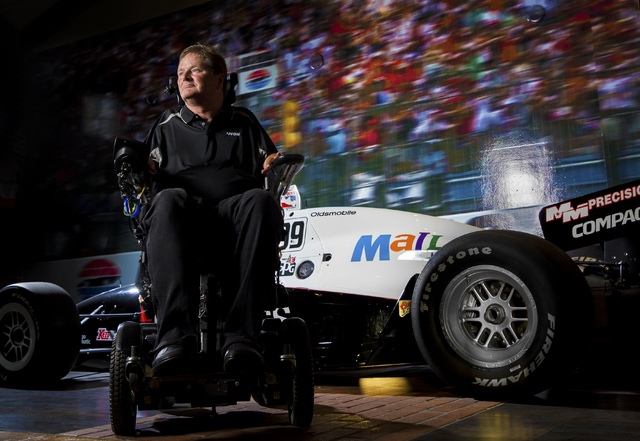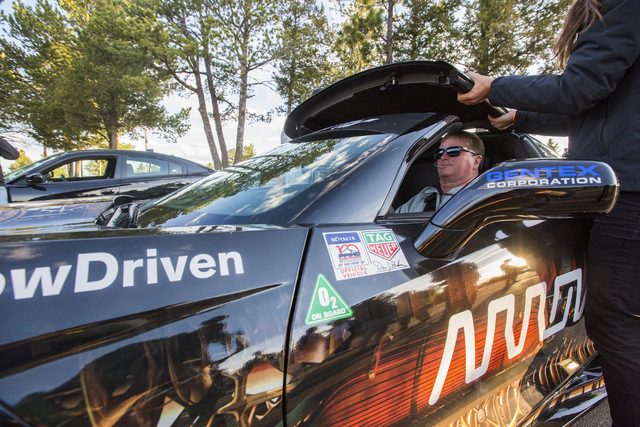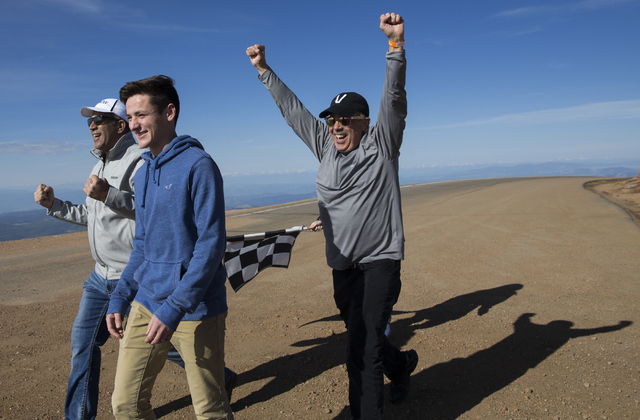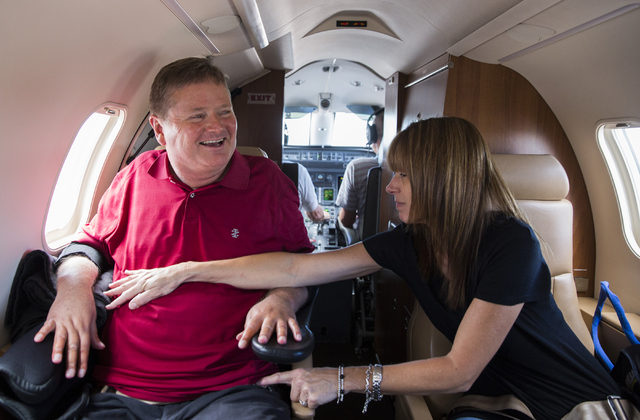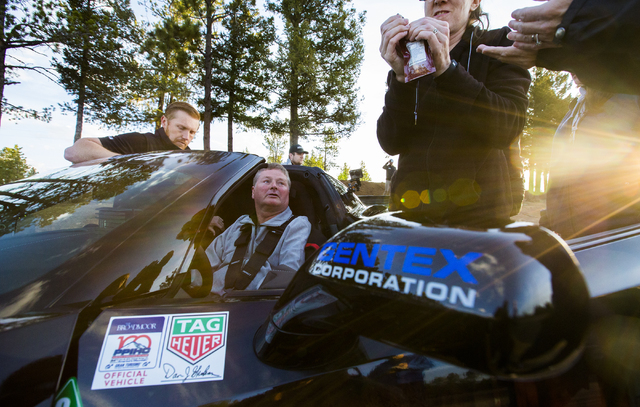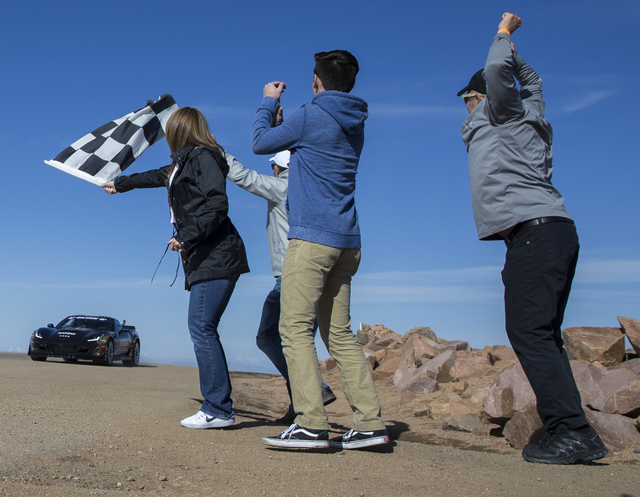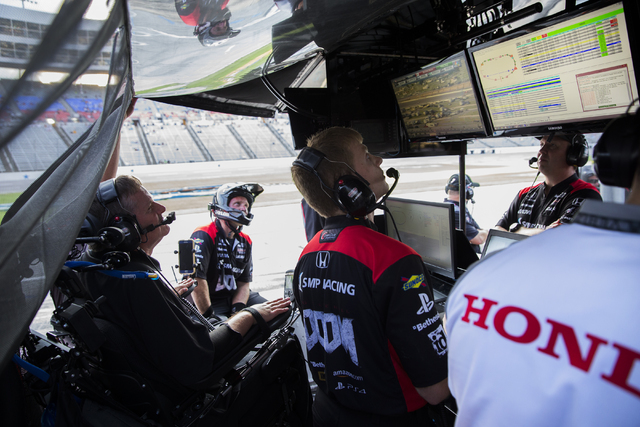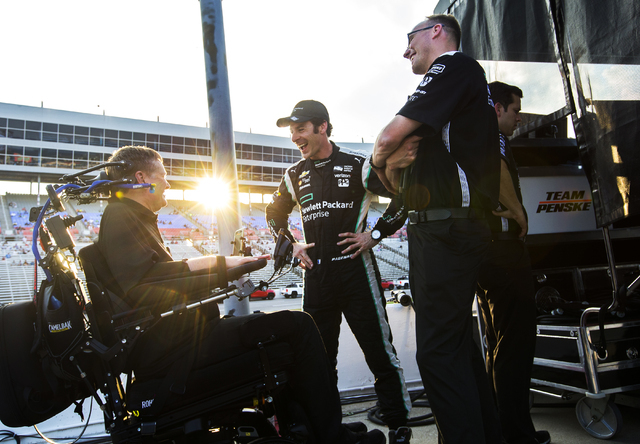Paralyzed Henderson resident Sam Schmidt reaches Pikes Peak summit
CASCADE, Colo. — It is a crisp June morning on Pikes Peak, as all mornings here are. It is a little past dawn. Automotive enthusiasts are gathered around racecars the way surgeons and nurses huddle around patients in operating rooms. Instead of sanitary scrubs, they wear racing jackets and beanies pulled down snug to ward off the chill.
There are no scalpels here. Tough on tires. The automotive enthusiasts wield wrenches and tote laptop computers.
They have a need for speed, though racing up the side of this mountain seems a diabolical way to satisfy it.
This is the last big practice run before the famous Pikes Peak Hill Climb — the historic 100-year anniversary of the famous Hill Climb, the 94th running of it. It is the second-oldest automobile race in the United States, trailing only the Indianapolis 500 in longevity.
One can feel the history up here. One also can smell the pines.
The starting line is little more than a clearing in the road. It is 9,390 feet above sea level. The summit, where the checkered flag is waved, is 14,110 feet above sea level. There aren’t any pine trees at the summit. There isn’t much of anything, really. Just a restaurant that isn’t open, and a bunch of cuddly marmots, and a majestic wide-open space that sprawls endlessly below.
The serpentine Hill Climb “track” measures 12.2 miles. It consists of 156 turns. And scant few guardrails.
They call it The Race to the Clouds.
It is an apt description.
When one races to the clouds with a little too much enthusiasm, there may be consequences to pay. Serious consequences.
Did I mention there are scant few guardrails?
You make a mistake climbing the hill, you may come tumbling down in a hurry. If one is lucky, he lands shiny side up. Hopefully, it won’t be in Pueblo.
Standing at the starting line and looking up, it seems a long way to summit. It looks cold up there. Standing at the starting line, all you can see are gray, craggy peaks partially draped in snow.
The fast cars make it up the hill in around nine minutes.
In 2013, Sebastien Loeb, the World Rally luminary, made it up in 8:13.978 in a Peugeot 208 T16. You can’t buy one of those off the showroom floor in Sochaux. Last year, Rhys Millen, who in 2008 flipped a truck over at the Rio during a nationally televised stunt on New Year’s Eve, made it up in 9:07.222 in a sleek electric powered car built in Latvia called the eO PPO3.
Millen’s car runs on a 50-kilowatt lithium-ion battery pack driving six YASA-400 electric motors. It makes a Toyota Prius sound like Detroit Muscle. Not even the cuddly marmots beyond the tree line can hear Millen coming on race day.
Rhys Millen, from New Zealand, is one of those milling about the starting line before the big training run.
So is Sam Schmidt, the IndyCar race team owner from Henderson.
Millen is wearing spiffy driving coveralls. It’s hard to see what Sam Schmidt is wearing. He is confined to a wheelchair, and there are myriad auto racing enthusiasts and technicians wearing racing jackets and beanies pulled snug around him.
Sam Schmidt once raced in the Indianapolis 500. He raced in the big one three times before a testing accident at Walt Disney World, of all places, rendered him a quadriplegic.
Schmidt is paralyzed from the chest down. He’s been in the chair for 17 years.
He will steer his car, the specially equipped No. 5 Arrow Electronics Corvette, by turning his head to and fro, activating sensors in his hat. He will speed up and slow down by blowing and sucking through a tube.
This may explain the woman standing off to the side, away from the mechanics and the lab coats, with her hands folded together and fingers interlocked in silent supplication. This is Sheila Schmidt, Sam’s wife.
“Out of sight, out of mind,” she says. This is the first time she will have seen her husband drive a car since the crash that irrevocably changed his life. “It’s better for me never to see it.”
Rhys Millen hunkers down into his sleek No. 67 car. The electric engine is engaged. Miller starts to speed up the mountain. Perhaps if an electric engine roared instead of hummed, it might have broken the tension.
On this day, that responsibility falls to Robby Unser — the son and nephew of racing legends Bobby and Al Unser, Sam Schmidt’s co-driver.
Because there are scant few guardrails en route to the summit, it was suggested Schmidt take along somebody for the ride, just in case. Robby Unser seems like the perfect fit. He has won the Hill Climb nine times; his famous racing family has accumulated 35 class titles here. The Unsers know their way around this mountain.
On this day, just before Sam Schmidt will start his engine and attempt to race to the clouds, Robby Unser makes a final pit stop. He announces he is headed for the Porta-Potti.
Tension is broken.
— — — —
On the homepage of the Arrow Electronics SAM Project is a stark mission statement:
“Fifteen years ago, doctors told Sam Schmidt he’d never move his arms or legs again. They didn’t say anything about driving.”
That was the inspiration behind the SAM Project, and the SAM car.
SAM is an acronym for Semi-Autonomous Motorcar. It’s also short for Samuel. That its driver has the same first name was not a coincidence.
“The way the whole program has evolved — right place, right time, karma or whatever saying you want to use is appropriate,” Schmidt, 51, said on the day before the SAM car was hauled to the Pikes Peak starting line at the crack of dawn. “It was basically my relationship with Arrow.”
Arrow Electronics is a Fortune 500 company with headquarters in Centennial, Colorado. It has around 17,000 employees and annual revenue of $23 billion. It specializes in distribution and value added services relating to electronic components and products such as computers. It has an aerospace and defense division, and other divisions.
But it was the value-added services that brought Sam Schmidt and Arrow together. Schmidt has a foundation that supports a brain and spinal injury facility at Craig Hospital in Englewood, Colorado, of which the Arrow company also is a benefactor.
“A lot of people who get hurt in Vegas wind up going there,” Schmidt said.
The Arrow company provides value-added services for these Las Vegans, and for other injury victims who are sent to Colorado for treatment, rehabilitation and therapy.
Arrow wanted to get the word out about the things they do to make a person’s life more worthwhile.
Sam Schmidt wanted to drive a car again.
“So they are sitting around, brainstorming — how can we show what we do to the world?” Schmidt said as a private jet whisked him, his family and two reporters to Colorado Springs in style.
“Let’s find somebody who can’t use his arms and legs and build a car for them. Do you know anybody who can’t use his arms and legs and might want to drive a car?”
If Sam Schmidt could have raised his hand, he would have done it and waved it around like Arnold Horshack in Mr. Kotter’s class.
He received a phone call. He was asked if he was interested in driving a car again.
“Usually when somebody calls and asks a question like that, the first thing I ask is how much is it going to cost,” Schmidt said.
No, he was told by the Arrow people. We have the technology and the budget. You can look us up on the internet.
“So I did. I thought it was spelled Aero — A-E-R-O.”
So thus was born the SAM project, and the SAM car.
Sam Schmidt learned how to spell Arrow. And in a few short months, he would be driving a specially equipped Corvette around venerable Indianapolis Motor Speedway before the 2014 500-mile race by tilting his head to and fro, and by blowing and sucking through a tube.
These Arrow engineers are amazing, Sam Schmidt said. What a team. Even rival car owner Roger Penske would be impressed.
“We have to go 100 miles per hour,” Schmidt told the guys and gals in the Arrow lab coats. “If we’re going to do this, we’re not going to putz around the track … ”
He went 97 mph. Not exactly putzing around. But not 100 mph, either. The speedway people got lots of footage, and it was sent to the networks, and it made for a really nice story. But Sam Schmidt wasn’t satisfied.
The day after the 500, he crashed the ceremonial photograph session of the winning car and driver. He brought the Arrow lab coats with him. When Ryan Hunter-Reay was done saying “cheese,” Schmidt took the SAM car back out on the big oval and went 107 mph.
The lab coats were just getting started. They put their laptops to work and made the SAM car more responsive. They made it faster.
In May, Sam Schmidt hit 158 mph in the speed traps on Carb Day, the final day of practice at Indy. A crowd of more than 100,000 cheered. When Parnelli Jones was driving at Indy, 158 mph in the speed trap would have put a guy on the front row.
An envelope had been pushed. Schmidt and the lab coats wanted to push it further.
They were sitting at an upscale restaurant the night before Schmidt would attempt to race to the clouds. They were drinking wine. Robby Unser was telling colorful stories about his old man and his Uncle Al and former Formula One team owner Teddy Yip gallivanting around the Far East.
One of the lab coats arrived late. She missed some of the stories, and some of the wine.
Noel Marshall was Sam Schmidt’s co-driver last year. She was on the mountain, helping to prepare the car, and that’s why she missed some of the stories, and some of the wine. She said she has developed a fond admiration for the man sitting in the middle of the table, who was being fed forks of meat by his loving wife.
“We are giving back that which was taken from him,” Noel Marshall says about Sam Schmidt on her page on the Arrow website. “That is the greatest feeling in the world, and the singular reason this project is the most significant project I’ve ever been a part of.”
In a few hours, it would be 4:30 a.m. The lab coats and the SAM car would be headed toward the conspicuous snow-capped peak south of town. Sam Schmidt would be sitting in the hotel lobby, telling a reporter he was feeling butterflies.
He said it was the same way he felt before he drove his Indy car.
— — — —
Security is tight on Pikes Peak during a test day; visitors are told they must remain at the starting line while the cars and drivers race to the clouds. But word literally comes from on high that those who have come to watch Sam Schmidt race to the clouds will be allowed to drive up the summit before he starts his run.
It is 44 degrees when we arrive at the summit after passing the cuddly marmots beyond the treeline. The serpentine course is totally paved now, the last stretch of gravel having been covered a few years back. It’s still mostly devoid of guardrails.
The man at the top holding the checkered flag asks Sheila Schmidt and Spencer Schmidt if they would like to wave it when Sam arrives at the top of Pikes Peak.
Spencer Schmidt is Sam’s teenage son. He was the one who drove us to the top of the mountain. He was looking at the cuddly marmots when he should have been looking at the narrow ribbon of road, at least in his mother’s estimation.
Sheila Schmidt and Spencer Schmidt do a few practice flourishes with the checkered flag as the photographers pick out their spots.
If there are cars racing to the top, you can’t hear them. A forlorn wind blows, but at 14,110 feet, there are no pine trees to make it whistle.
It’s lonely at the top of Pikes Peak on the last big test day.
“You won’t be able to hear them until they get to Boulder Park,” says the man holding the checkered flag.
Boulder Park is a dot on the course, 13,380 feet up.
Suddenly, a car appears. It’s Rhys Millen in the sleek eO PPO3. A time is shared, a head is shaken. Could have been better.
Paul Dallenbach, representing another famous racing family, comes up next. You can’t hear him, either — the engine in his open-wheel car, purposely built to race to the clouds, is silent. He had a problem coming up. He’d lose power, get it back, lose it again.
Combustion engines can be finicky running in the rarefied air of Pikes Peak.
Then, from down the mountain, an engine sound.
Is it Sam and Robby Unser?
The walkie-talkie cackles in confirmation.
The man with the checkered flag hands it to Sheila Schmidt. “Wave that flag like you mean it, Sheila.”
Sheila Schmidt waves the flag as if the practice run is the Monaco Grand Prix and her husband is Juan Manuel Fangio.
Unlike Rhys Millen and Paul Dallenbach, Sam Schmidt races across the summit of Pikes Peak at a high rate of speed. He knows the Arrow lab coats have hired a film crew for a documentary.
Onlookers cheer as Schmidt pulls the SAM car around for photos.
“Woo!” exclaims Robby Unser.
Sam Schmidt doesn’t speak at first. He’s either too exhilarated, or too exhausted. People wearing racing jackets and beanies congratulate him. He mentions the clouds and the blue sky and the lack of guardrails between gasps of rarefied air.
“That’s the craziest thing I’ve ever done,” he says after catching his breath. “And I’ve done a lot of crazy things.”
Robby Unser says you should have seen the way Sam ripped around those 153 turns.
A reporter looks up from his notebook.
“I thought there were 156 turns.”
“Maybe there are,” Unser says. “But I think Sam straightened out about three of ’em.”
That was two weeks ago.
On Sunday when Sam Schmidt races to the clouds during the 100th anniversary of the famous Pikes Peak International Hill Climb, the 94th running of it, he hopes to show again there is no limit to what a man can do, if a man has courage and conviction and a loving family and a team of talented and dedicated lab coats behind him.
He’ll also be trying to straighten out a few more of those turns.
Las Vegas Review-Journal sports columnist Ron Kantowski can be reached at rkantowski@reviewjournal.com or 702-383-0352. Follow him on Twitter: @ronkantowski.
RELATED ITEMS
Welcome to the hectic lifestyle of IndyCar team owner and quadriplegic Sam Schmidt




